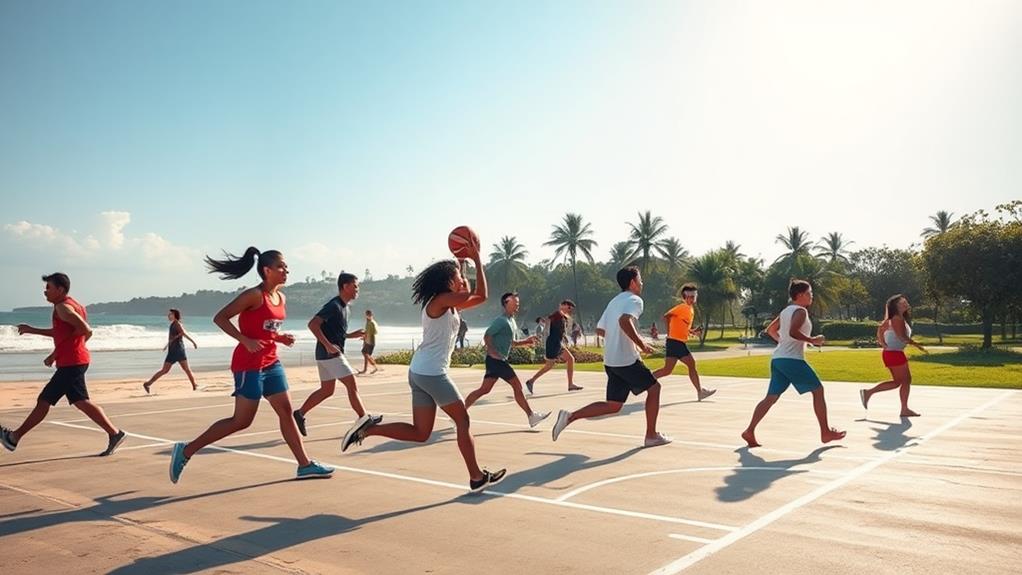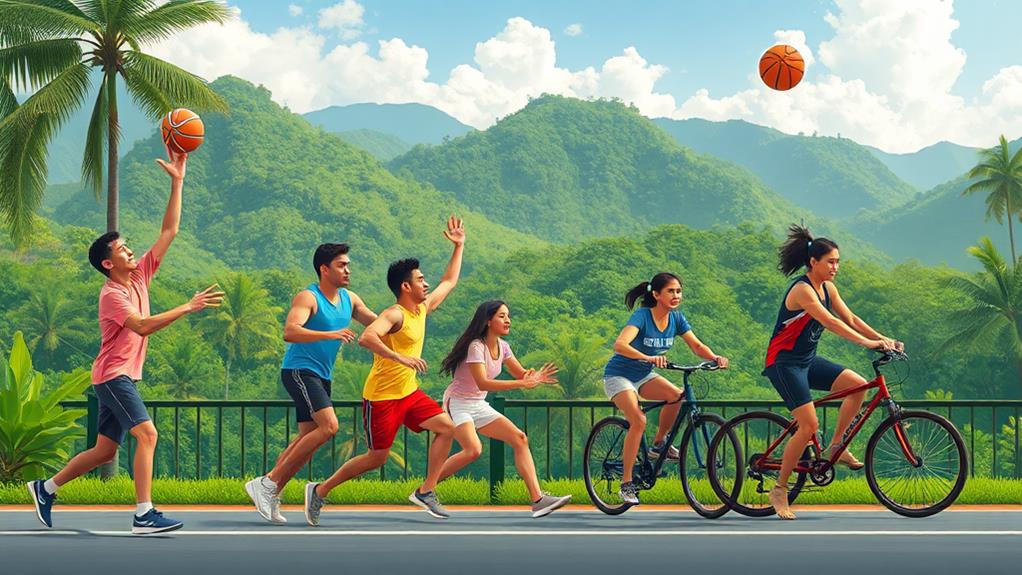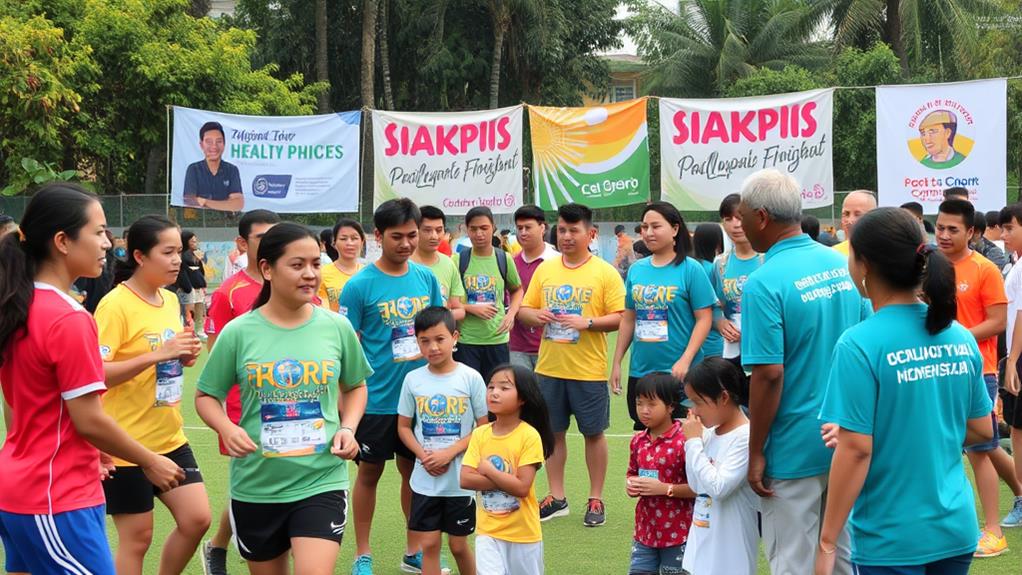Understanding the Importance of an Active Lifestyle
Promoting an active lifestyle is crucial in the Philippines, where 82.7% of Filipino youth do not meet recommended physical activity levels, leading to significant health risks.
Current Challenges and Efforts
The government has initiated policies to enhance sports participation and create safe public spaces.
However, many efforts lack accountability and inclusivity, especially for non-athletes.
Fostering Healthier Habits
To address this issue, engaging families, schools, and communities is key.
This can be achieved by implementing programs that encourage physical activity and healthy habits from a young age.
Key Recommendations
Include non-athletes in sports programs to promote inclusivity and increase funding for sports infrastructure to create safe public spaces.
Additionally, integrate physical education into school curricula to foster healthier habits from an early age.
Importance of Active Lifestyles

Active lifestyles are crucial for maintaining both physical and mental well-being, especially among young people. Engaging in at least 60 minutes of daily physical activity is essential for children and adolescents, as recommended by the World Health Organization (WHO).
In the Philippines, however, a staggering 82.7% of 10- to 17-year-olds fail to meet these guidelines, revealing a significant public health concern.
Regular physical activity serves as a preventive measure against non-communicable diseases (NCDs). NCDs are projected to account for 500 million new cases globally in the next decade, with an estimated economic burden of USD 27 billion.
Establishing active habits early on leads to better health perceptions in adulthood. By reducing sedentary behavior and encouraging regular engagement in sports or exercise, individuals can help pave the way for a healthier future.
Embracing active lifestyles is vital for the youth in the Philippines. This can be achieved by prioritizing physical activity and promoting regular exercise or sports participation.
By doing so, individuals can ensure their long-term health and well-being.
Government Initiatives and Policies
Government initiatives significantly shape the landscape of physical activity in the Philippines. The Philippine government has launched various initiatives to promote physical activity, with 17 government policies earning an A- grade for effectiveness in the 2022 Philippine Physical Activity Report Card.
47% of these initiatives focus on sports participation, while 23% prioritize active transport.
One notable example is the Healthy Public Open Spaces Initiative, which involves eight national agencies working together to create safe public areas that encourage community engagement and support mental well-being.
Additionally, a joint administrative order has led to the improvement or construction of over 500 km of bicycle lanes since 2021, promoting active transport among citizens.
Despite these advancements, policy implementation and reporting structures need improvement. A significant issue is that 53% of policies lack explicit accountability measures, hindering their overall effectiveness.
Proper implementation and accountability are crucial for sustainable progress. With continued focus and refinement, these initiatives can further energize communities across the Philippines.
Current Physical Activity Statistics

Physical Activity Crisis Among Filipino Youth
82.7% of Filipino youth aged 10-17 fail to meet the World Health Organization's physical activity recommendations of 60 minutes daily. This alarming trend contributes to rising rates of sedentary behavior and negatively impacts their health.
For example, a lack of physical activity is linked to an increased risk of obesity, diabetes, and other health problems.
Limited Physical Activity Policies for Children Under 5
Only 10% of the Filipino population consists of children under 5, yet there are few targeted physical activity policies for this age group.
This is concerning because early childhood is a critical period for developing healthy habits and physical literacy.
Low Sports Participation Among Filipinos
39% of the population is between 5 and 24 years old, making it crucial to implement effective government policies that promote sports participation and an active lifestyle.
However, 41% of adults report insufficient physical activity, further increasing the risk of non-communicable diseases (NCDs).
Urgent Need for Improved Physical Activity Initiatives
The overall failing grade (F) assigned to youth physical activity underscores the pressing need for improved engagement and healthy lifestyle initiatives.
Prioritizing physical activity and developing comprehensive strategies for all age groups is essential for fostering a healthier, more active nation.
Influences on Youth Participation
Family and peer support significantly influence physical activity levels among Filipino youth. These social networks can either encourage or discourage participation in physical activities, shaping individual preferences and opportunities. For instance, having family members or friends who engage in sports can motivate youth to do the same.
Schools play a crucial role in promoting physical activity. Over half of the initiatives aimed at promoting sports and exercise occur within educational settings. However, only 17.3% of Filipino youth aged 10 to 17 meet the World Health Organization's (WHO) recommended physical activity levels, highlighting the need for more effective engagement strategies.
Community resources and local government policies are essential for fostering an active lifestyle. Despite the focus on athletic youth, non-athletes and out-of-school youth, who comprise 5.5% of Filipinos aged 5 to 17, are often overlooked.
To address this, targeted policies that include diverse youth populations are necessary to ensure everyone has access to physical activities. By aligning community resources with effective engagement strategies, we can increase youth participation and cultivate a healthier generation of Filipino youth.
Addressing Policy Gaps

Addressing policy gaps is crucial for promoting physical activity among Filipino youth. Current policies primarily focus on organized sports, neglecting non-athletes and the 5.5% of out-of-school youth who lack targeted initiatives. This oversight is particularly concerning for children under five, who require early childhood engagement to develop healthy habits.
Existing policies have scored only 7 out of 10 in evaluations, indicating a lack of comprehensive coverage. 53% of policies focus on schools and 41% on community settings, revealing an insufficient approach that fails to address the diverse needs of all youth.
Without specific guidelines on reducing inactivity, the path to fostering an active lifestyle remains obstructed.
A nationally representative study is essential to assess the impact of these policies across various demographics. By understanding how different groups respond to health promotion strategies, we can tailor initiatives that encourage youth participation in physical activity.
It's time to expand our focus and create inclusive policies that support the physical well-being of all Filipino youth, ensuring a healthier future for everyone.
Recommendations for Improvement
Creating a Comprehensive National Physical Activity Plan
To address the alarming inactivity of Filipino youth, a comprehensive national physical activity plan is essential. 82.7% of Filipino youth fail to meet recommended activity levels, making it crucial to tackle sedentary behavior. This plan should expand government policies to include informal play and active transport, encouraging participation among non-athletes and out-of-school youth, who currently lack targeted initiatives.
Collaboration and Effective Health Policies
Collaboration among government agencies, civil society, and NGOs is vital. By working together, these entities can advocate for effective health policies that promote physical activity and establish clear roles and responsibilities.
For instance, they can develop policies that incorporate physical education into school curricula or create bike-friendly infrastructure.
Improving data reporting mechanisms is crucial, as 53% of existing policies lack explicit reporting systems, hindering accountability and the evaluation of physical activity programs.
Questions and Answers
What Is the Importance of Sport in the Philippines?
Sport is essential in the Philippines for several reasons.
It fosters community engagement and youth development by providing a platform for people to come together, build relationships, and develop teamwork skills.
For instance, the Philippine Sports Commission's grassroots programs have successfully promoted sports development in rural areas, empowering young athletes to become leaders in their communities.
It helps build a sense of cultural identity by promoting national pride and unity.
The country's passion for basketball, for example, has brought people together, transcending social classes and geographical boundaries.
Sports can boost the economy through tourism and infrastructure development.
The hosting of international sports events, such as the Southeast Asian Games, has generated significant revenue and created jobs for Filipinos.
It promotes health benefits by encouraging physical activity and a healthy lifestyle.
The government's "Sports for All" program has made sports accessible to people of all ages, reducing the risk of chronic diseases and improving overall well-being.
Integrating education with sports prepares individuals for international competition and enhances personal and professional growth.
The University of the Philippines' sports programs, for instance, have produced athletes who've excelled in international competitions, earning scholarships and securing careers in their chosen fields.
Overall, sport is a powerful tool that shapes individuals and communities, driving positive change across various aspects of life.
What Is the Healthy Lifestyle Society of the Philippines?
The Healthy Lifestyle Society of the Philippines (HLS-PH) promotes a healthy lifestyle through community engagement and wellness initiatives. This organization focuses on two primary areas: fitness programs and nutrition education workshops.
Fitness programs aim to foster active living among Filipinos, while nutrition education workshops provide knowledge on healthy eating habits.
HLS-PH emphasizes youth involvement to combat lifestyle diseases and cultivate a fitness culture. This is achieved by organizing fitness programs and workshops specifically designed for the youth, empowering them to make informed choices about their health.
Collaboration with various organizations is key to HLS-PH's success. By working together, they enhance public health and encourage healthier habits across communities, ultimately creating a vibrant, health-conscious society.
What Are Philippine National Guidelines on Physical Activity?
The Philippine National Guidelines on Physical Activity recommend at least 60 minutes of moderate-to-vigorous exercise daily. These guidelines prioritize youth participation in various activities, including sports education, to enhance health benefits.
For instance, incorporating physical education in school curricula encourages children to engage in regular exercise. Additionally, promoting active transportation, such as walking or cycling to school, contributes to the recommended daily exercise duration.
The government aims to facilitate lifestyle changes through community engagement and wellness programs. These initiatives help combat sedentary behavior by providing opportunities for people to engage in physical activities, such as sports tournaments, fitness classes, or outdoor recreational activities.
What Are the Sports and Leisure in the Philippines?
Sports and Leisure in the Philippines
The Philippines boasts a rich cultural heritage in sports and leisure activities. Basketball is an extremely popular sport, with many Filipinos playing in local courts and following international leagues.
Additionally, Arnis, a traditional martial art, is a staple in Philippine sports. This ancient form of self-defense isn't only a recreational activity but also a way to connect with the country's history and culture.
Outdoor enthusiasts will find plenty of opportunities to engage in water sports and hiking in the Philippines' scenic regions. With over 7,000 islands, the country offers a diverse range of landscapes and seascapes perfect for outdoor adventures.
Fitness trends are on the rise, driven by community events that encourage youth participation and promote active living. As a result, recreational facilities are expanding, providing more options for people to engage in sports and fitness activities.
Engaging in these sports and leisure activities not only boosts physical health but also fosters community spirit and social connections.